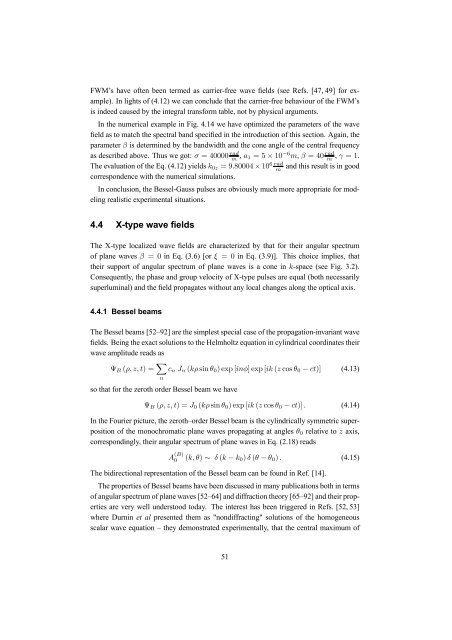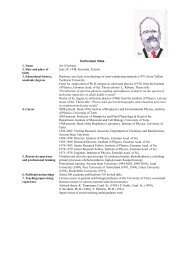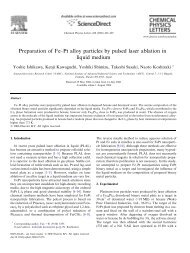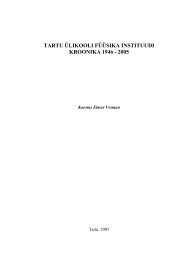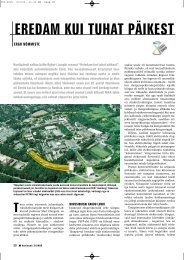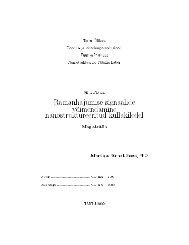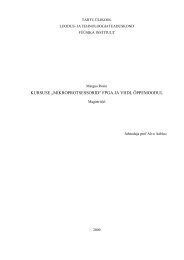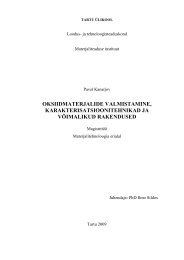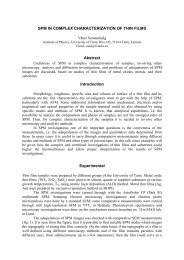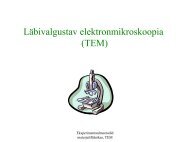Optical implementation of propagation-invariant pulsed free ... - Tartu
Optical implementation of propagation-invariant pulsed free ... - Tartu
Optical implementation of propagation-invariant pulsed free ... - Tartu
You also want an ePaper? Increase the reach of your titles
YUMPU automatically turns print PDFs into web optimized ePapers that Google loves.
FWM’s have <strong>of</strong>ten been termed as carrier-<strong>free</strong> wave fields (see Refs. [47, 49] for example).In lights <strong>of</strong> (4.12) we can conclude that the carrier-<strong>free</strong> behaviour <strong>of</strong> the FWM’sis indeed caused by the integral transform table, not by physical arguments.In the numerical example in Fig. 4.14 we have optimized the parameters <strong>of</strong> the wavefield as to match the spectral band specified in the introduction <strong>of</strong> this section. Again, theparameter β is determined by the bandwidth and the cone angle <strong>of</strong> the central frequencyas described above. Thus we got: σ = 40000 radm , a 1 =5× 10 −6 m, β =40 radm , γ =1.The evaluation <strong>of</strong> the Eq. (4.12) yields k 0z =9.80004 × 10 6 radmand this result is in goodcorrespondence with the numerical simulations.In conclusion, the Bessel-Gauss pulses are obviously much more appropriate for modelingrealistic experimental situations.4.4 X-type wave fieldsThe X-type localized wave fields are characterized by that for their angular spectrum<strong>of</strong> plane waves β =0in Eq. (3.6) [or ξ =0in Eq. (3.9)]. This choice implies, thattheir support <strong>of</strong> angular spectrum <strong>of</strong> plane waves is a cone in k-space (see Fig. 3.2).Consequently, the phase and group velocity <strong>of</strong> X-type pulses are equal (both necessarilysuperluminal) and the field propagates without any local changes along the optical axis.4.4.1 Bessel beamsThe Bessel beams [52–92] are the simplest special case <strong>of</strong> the <strong>propagation</strong>-<strong>invariant</strong> wavefields. Being the exact solutions to the Helmholtz equation in cylindrical coordinates theirwave amplitude reads asΨ B (ρ, z, t) = X nc n J n (kρ sin θ 0 )exp[inφ]exp[ik (z cos θ 0 − ct)] (4.13)so that for the zeroth order Bessel beam we haveΨ B (ρ, z, t) =J 0 (kρ sin θ 0 )exp[ik (z cos θ 0 − ct)] . (4.14)In the Fourier picture, the zeroth–order Bessel beam is the cylindrically symmetric superposition<strong>of</strong> the monochromatic plane waves propagating at angles θ 0 relative to z axis,correspondingly, their angular spectrum <strong>of</strong> plane waves in Eq. (2.18) readsA (B)0 (k, θ) ∼ δ (k − k 0 ) δ (θ − θ 0 ) . (4.15)The bidirectional representation <strong>of</strong> the Bessel beam can be found in Ref. [14].The properties <strong>of</strong> Bessel beams have been discussed in many publications both in terms<strong>of</strong> angular spectrum <strong>of</strong> plane waves [52–64] and diffraction theory [65–92] and their propertiesare very well understood today. The interest has been triggered in Refs. [52, 53]where Durnin et al presented them as "nondiffracting" solutions <strong>of</strong> the homogeneousscalar wave equation – they demonstrated experimentally, that the central maximum <strong>of</strong>51


